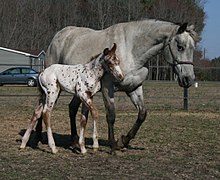Appaloosa
| Appaloosa | |
|---|---|

|
|
| Important data | |
| Origin: | North America ; Palouse Prairie Idaho |
| Main breeding area: | mainly USA |
| Distribution: | worldwide |
| Stick measure : | 142-165 cm |
| Colors : | all except platter, characteristic saddle rack markings |
| Main application area: | Riding and driving horse |
Appaloosa is a breed of horse derived from the Spanish horse that was imported into North America in the 18th century . Their development is said to come from the Nez Percé in North America. Appaloosas are recreational or sport horses that are particularly popular in the western sector.
Background information on horse evaluation and breeding can be found under: Exterior , interior and horse breeding .
Exterior
Appaloosa have a typical body structure for western horses in a mostly square frame. This includes a small head that fits the horse with large, alert eyes and a straight nose line, an oblique, well-muscled shoulder, a short, strong back and a sloping croup, also strongly muscled. These qualities enable the horses to be fast and agile, especially over short distances, as was particularly needed in the past on ranch work in America. Nowadays, however, specialized types are also bred, depending on the purpose for which you want to use them. Otherwise, the horses stand out due to their characteristic color patch pattern.
The characteristic features, by which one can also recognize many monochrome Appaloosa, are the "human eye" and the spotted skin, which can be recognized wherever it is not covered by fur, e.g. B. on the nostrils, around the eyes or on the genitals. The striped hooves with a dark crown edge are also caused in this way. These characteristics are also used as a criterion for the regular registration of horses.
The patterns of the tiger drawing are:
- Schabracktiger / engl. Blanket with spots: White blanket over the back and hips with dark spots.
- Schabracktiger / engl. Blanket without spots: White blanket over the back and hips without dark spots.
- Snowflake snowflake. The snowflake is part of the Roan drawing of the tiger piebald.
- Roan / (Varnish) Roan:
- Frost: Dark basic color with isolated white hairs.
- Leopard / full tiger
- Near leopard
- Few Spot / White Born
- Snowcap
The tiger piebald can go through a strong color change in the course of its life, ie the basic color can be lightened, so it can be increasingly interspersed with white hair ("uproan"), or they get white spots. The color of a horse can change to a greater or lesser extent over time.
All basic colors are permitted with the exception of the plate check (characteristic of paint horses = undesirable) and mold. The mold has the property of covering the drawing of the Appaloosa and destroying it to pure white. Mold used to be crossed, but today the mold color is excluded.
The breeding of the Appaloosa horse is a color breeding, but at least as much value attaches to the correctness of the building and interior of the horse. Mating two “colorful” Appaloosas does not necessarily result in “colorful” foals, but also foals without characteristics and without typical coat markings.
interior
The Appaloosa has perseverance, willingness to perform and a people-centric approach. But above all, his calm and serenity qualify him, these characteristics make him suitable for family and sport horses.
Breeding history
It is known through illustrations that spotted horses were known for a long time in the Old World . It can be assumed that these horses came to the New World through the Spanish conquerors , where they left their traces on the Mustangs of North America through naturalization .
The Nez Percé Indian tribe lived in the Palouse prairie in Idaho , and they are the only ones known to have practiced systematic horse breeding. Derived from the breeding area, the Appaloosa also got its name. In a legendary escape, the Nez Percé tried to escape the annihilation by the white man in 1877, but ultimately failed. Most of the horses lost their lives on this trek, so that only a small population could be maintained.
From 1938 onwards, a breeding population was developed from these small stocks, which had grown to over 500,000 animals by the end of the 20th century. The breed is one of the most popular horses in North America after the Quarter Horse and the Paint Horse and has also expanded its popularity across borders back to the Old World.
The first horses of this breed came to Germany in 1975. Their track was lost because there were only a few horses that could not be classified correctly. In 1978 a small group of admirers of pure-bred Appaloosa horses made the decision to found the Appaloosa Horse Studbook Germany eV, which set itself the task:
- to record the Appaloosa horses present in the Federal Republic,
- To inform Appaloosa friends and breeders and to represent their interests,
- to promote the Appaloosa breed,
- to obtain recognition of an independent breeding association in Germany as soon as possible.
In 1994 the Appaloosa Horse Club Germany was founded, which today looks after this breed in Germany.
The administration of the studbook in North America is in the hands of the Appaloosa Horse Club based in Moscow , where a large information center has also been established.
The requirements of this mother association in the USA allow the crossbreeding of Quarter Horses, Arabian and English Thoroughbred, whereby the quality of the Appaloosa breed was sustainably improved. In addition to recreational horses, you will also find specialists such as holding, pleasure, reining horses or cutting lines at the Appaloosas, which are particularly suitable for use in the respective discipline in tournament sports.

